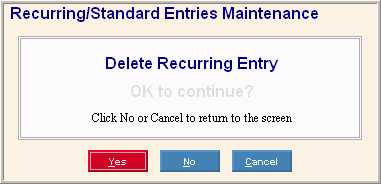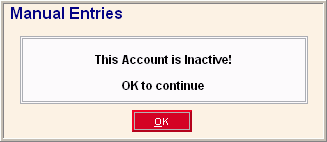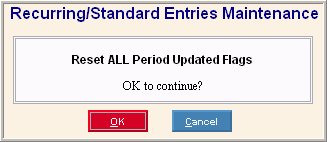Opening Recurring-Standard Entries Maintenance, click More.
-
Basic Method (from the G/L Module):
-
Click File Maintenance from the Menu Bar.
-
Click Recurring-Standard Entries.
Tip: Or, use the keyboard shortcut: [ALT] [m] [r].
-
Advanced Method (from another NDS Module):
-
Click General Ledger from the Menu Bar.
-
Click File Maintenance.
-
Click Recurring-Standard Entries.
Tip: Or, use the keyboard shortcut: [ALT] [g] [m] [r].
Note: To activate the General Ledger menu in another module, the G/L Application Control must be set up for the module during installation.
Recurring-Standard Entries Maintenance Window Example:

Creating a new Recurring or Standard Journal Entry Template, click More.
To create a new journal entry template:
-
Enter the new Reference.
-
Click Retrieve
 , or press
[ENTER].
, or press
[ENTER].
Keyboard shortcut: [ALT + t] -
Enter the Reference Description, Run Code, and Journal Code.
-
Click New
 or press [ENTER].
or press [ENTER]. -
Enter the debits and credits.
-
To finish, click Completed
 .
.
Tip: To
indicate that you are building a new journal entry template, New  displays near the Reference. Default
entries display and the first field is highlighted
to let you know you can begin entering information.
displays near the Reference. Default
entries display and the first field is highlighted
to let you know you can begin entering information.
|
Recurring Entries Maintenance Window Prompts Tip: To see more information about a field, click the hyperlink for the field name. | |
|
Enter a unique Reference to identify the template for the journal entry. (up to 20 characters) Tips:
| |
|
Enter a description for the journal entry template. (up to 30 characters) Tip: This description applies only to the templates for your convenience. When you create the live journal entries, it is not attached to the transactions. | |
|
|
To display an existing recurring journal entry template, enter the Reference and click Retrieve, or press [ENTER]. Keyboard shortcut: [ALT + t] |
|
Enter the optional Run Code, which you can use to group types of recurring journal entry templates together. When you create the live journal entries, you can select the templates to use by the Run Code. (3.0 numeric) Examples: You can use the following convention for Run Codes on the recurring journal entry templates, or you can create your own meaning for the Run Codes.
| |
|
Click one of the following Journal Codes in the drop-down list.
| |
|
Displays the description for the Account Number. | |
|
Enter the Account Number for the transaction. (format varies) Required. Tips:
| |
|
Enter an optional Transaction Description for each credit or debit transaction. (up to 30 characters) Tip: You can see the Transaction Description on the General Journal Listing and the General Journal Report after running Create Recurring Entries or Create Standard Entries for the period. | |
|
Click the Debit/Credit Option in the drop-down list. (predefined) | |
|
Enter the Transaction Amount for the credit or debit. (12.2 numeric) Note: Always enter the Transaction Amount as a positive number. To create a negative transaction, simply select the opposite Debit/Credit Option. Tip: If you override the amount for a Standard (ST) template during Create Standard Entries, it also changes the template amount here. | |
|
Transaction List |
The Transaction List displays the following fields in each row.
|
|
|
To add a new detail line for a transaction, click New. |
|
|
To delete a transaction line, click to highlight the line, and then click Delete. Tip: To delete an entire template, you must use the Delete Command on the File menu. For more information, refer to the delete section later in this topic. |
|
|
To save changes to a transaction line, click Save. |
|
|
To clear the window for entering a new journal entry template, click Completed. |
|
|
The Create Recurring Entries and Create Standard Entries routines set the Period Updated Flag to 1 for every processed journal entry template to prevent you from accidentally creating duplicates of the recurring and standard journal entries. If you want to regenerate standard or recurring journal entries in a specific period again, you can reset all the flags to 0 (zero) so you can run the create processes again for the same period:
Tip: You do not have to reset the flag for normal processing where you only run the generate the recurring and standard journal entries once per period. |
|
Balance |
Displays the sum of the debit and credit Transaction Amounts in the Transaction List. Note: Do not complete the journal entry template unless this value is 0.00 (zero). |
|
|
To close the Recurring Entries window:
|
Editing an existing Recurring or Standard Journal Entry Template, click More.
 CAUTION: To
avoid losing data, you must save new or changed records.
CAUTION: To
avoid losing data, you must save new or changed records.
-
To display the record to be changed, enter the Reference and click Retrieve
 ,
or press [ENTER].
,
or press [ENTER].
Keyboard shortcut: [ALT + t]
Tip: If you do not know the Reference, you can click Search to see
a list of recurring and standard journal entry templates.
to see
a list of recurring and standard journal entry templates. -
To position the pointer to the information that you want to change, press [TAB] or click the field using the mouse.
-
To enter data changes for a detail line:
-
In the Transaction List, click to highlight the line to change.
-
Enter the changes.
-
Click Save
 .
. -
To complete the edit process, click Completed
 .
.
Deleting an existing Recurring or Standard Journal Entry Template, click More.
-
To display the record to be deleted, enter the Reference and click Retrieve
 ,
or press [ENTER].
,
or press [ENTER].
Keyboard shortcut: [ALT + t]
Tip: If you do not know the Reference, you can click Search to see
a list of recurring and standard templates.
to see
a list of recurring and standard templates.
-
Click File from the Menu Bar, and next click Delete.
Keyboard shortcut: [ALT] [f] [d] -
At the Delete prompt, click Yes to delete the record, or click Cancel to escape from the delete routine.
Example:
Note: After you click Yes, you will see the following message on the Status Bar.


